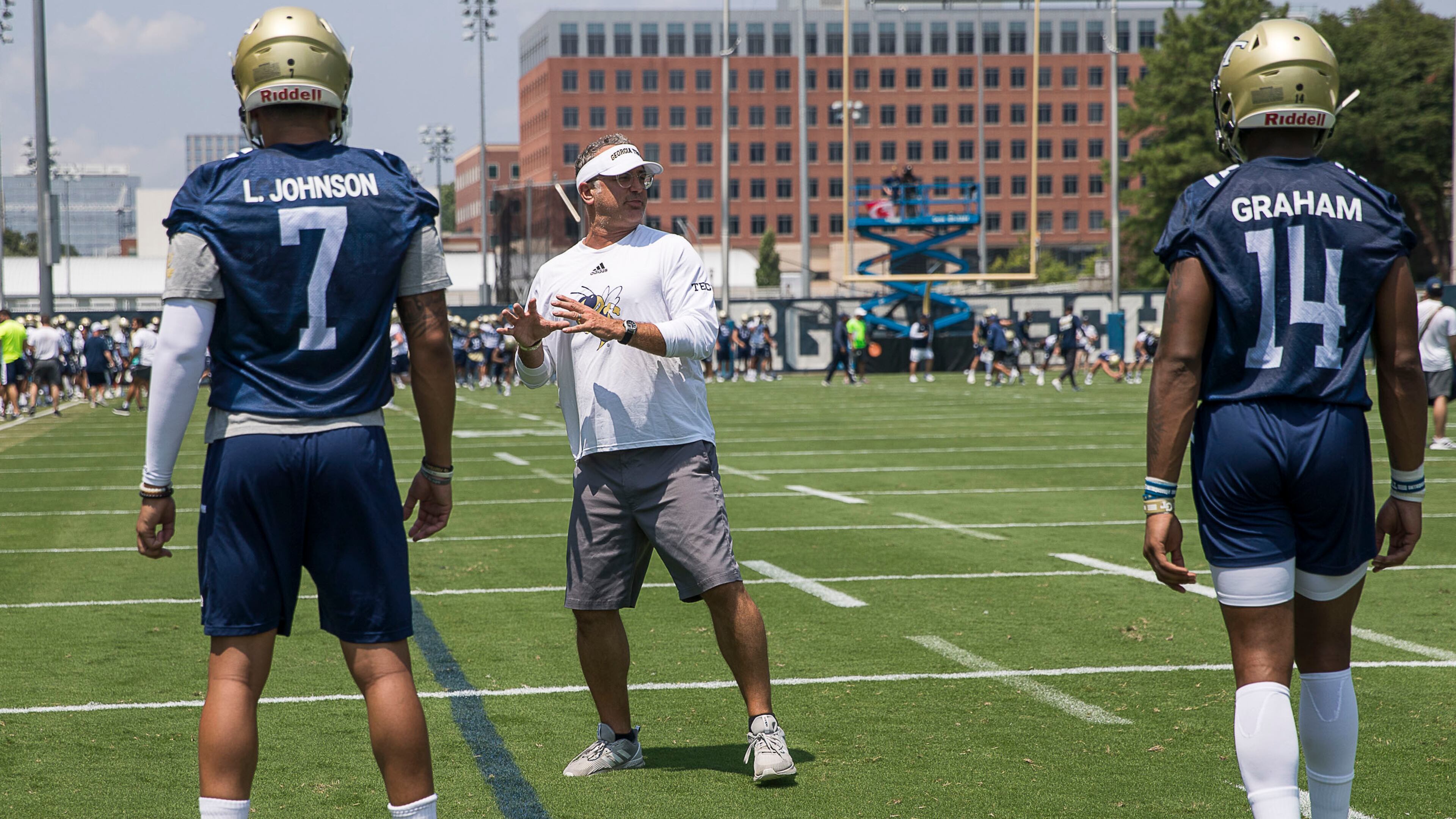Dave Patenaude’s vision for Georgia Tech offense clarifying

To figure out how to assemble his new offense, Georgia Tech offensive coordinator Dave Patenaude assessed his talent in winter workouts and then in 15 practices in the spring. He compared it with the Food Network show “Chopped,” where contestants receive a basket of ingredients and are challenged to make a meal out of it.
After a summer to contemplate and plan, Patenaude is ready to start cooking.
“I have a pretty good idea of what we’re going to want to be,” Patenaude said Thursday, following the Yellow Jackets’ second practice of the preseason. “I’m obviously not going to tell anybody else that. But I think we have a good general idea of what the guys are doing.”
As is par for the preseason, Patenaude spoke with optimism about what the Jackets can do with the ball this season. He positioned the vast depth at running back and the versatility of the former A-backs as strengths and scattered compliments for all of the offensive position groups like a child blowing a dandelion.
While questions and doubts abound about how Tech can effectively transition this season from former coach Paul Johnson’s option offense, Patenaude saw the variety of skillsets as an advantage.
“So the cool thing about what we do is we can put two good backs on the field and a tight end,” he said. “You can put two backs on the field and three wide receivers and just mix and match game to game or series to series, play to play.”
Patenaude said that he cross-trains his skill players at wide receiver, slot receiver, tight end and running back. He also relies on a wide diversity of formations and position groups.
“We don’t just say, ‘Hey, you’re a slot,’” Patenaude said. “Because (Thursday) in practice, (tight end Tyler Davis) played the slot and we moved (slot receiver Ahmarean Brown) outside. So what we teach them, it’s like, OK, this is what the scheme is, these are the concepts, this is what you do. If you get plugged in at A, B, C, D or E, this is what you have to do.”
Patenaude said that about 70 percent of the time, his offenses have used “11 personnel,” meaning one running back, one tight end and three receivers. But, given his assemblage of talent, including running backs such as Jordan Mason, Jerry Howard and freshman Jamious Griffin among a large crew, it won’t be a surprise to see Patenaude feature two backs and one tight end with two receivers.
That would seem especially likely as tight end Tyler Davis is the only experienced player at that position, with converted linebacker Tyler Cooksey and freshman Dylan Deveney the only other two scholarship players there.
“We’ve won a lot of games and moved the ball a lot with two backs in the backfield,” he said. “We’re really good with that.”
While Patenaude has typically been even in run/pass ratio, the Jackets could well lean to the run, given their strength at running back. Before he was at Temple, he was at Coastal Carolina, where one of his offenses had a 74/26 run/pass ratio because of limitations at quarterback.
But, Patenaude also said, things could change if someone like Deveney comes along, making an offense with two tight ends more of a possibility. And another factor is the versatility of a player like Nathan Cottrell, who played A-back for Johnson, worked at slot in the spring and has begun the preseason at running back. Using him as a running back but then moving him to the slot could pose more problems for defensive coordinators who are trying to anticipate Patenaude’s play calls based on the personnel grouping.
It can be assumed that his quarterback, most likely Lucas Johnson, will do plenty of running. While Temple’s quarterbacks ran 73 times last season out of 494 total carries, Patenaude has raved about the ability of Johnson, Tobias Oliver and James Graham to run and pass.
“We’ve answered this question (about having option quarterbacks) 1,000 times,” he said. “No, we’ve got really, really good dual (threat) quarterbacks. And they can run and throw, and that’s what you’re going to see.”
He also raved about wide receiver Malachi Carter.
“He’s playing at an unbelievable level right now,” he said. “I haven’t been around all of the ACC teams, but I’m not trading that dude for a lot of guys. He’s been really, really good.”
Davis “looks amazing,” Patenaude said, having put on 20 pounds of muscle to get to 255 pounds.
“Did you see Tyler Davis running down the middle of the field to catch a 65-yard touchdown pass?” he asked.
The offensive line, considered to be a potential weakness because of its lack of depth and the severe change in technique, looks “much better technically, and (offensive line coach Brent Key) has done an unbelievable job with them,” he said.
Patenaude has an idea of how it will all come together, but the tinkering probably isn’t done yet.
“I think for us it’s identifying who those guys are that are playmakers for us, or what our guys can handle up front, what the quarterbacks can handle and then kind of tailoring everything around what each individual guy can do,” he said.



